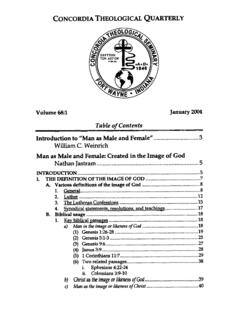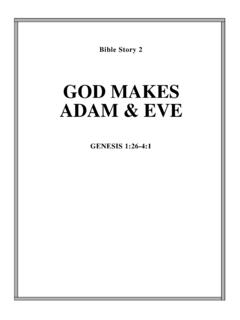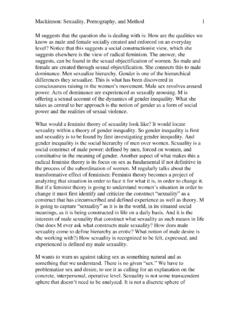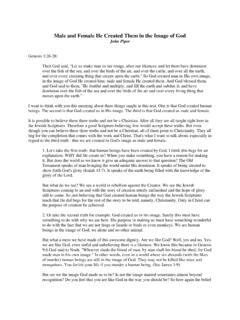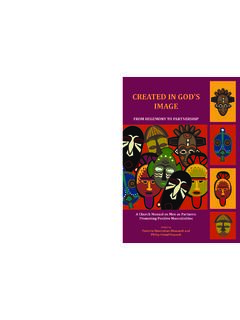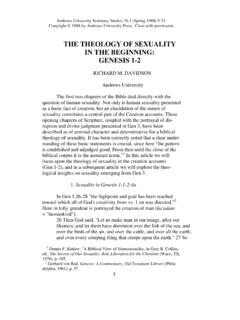Transcription of Pope John Paul II’s Theology of the Body
1 Fr. Roger J. LandryEspirito Santo ParishFall River, MALent 2003 Pope John Paul II s Theology of the BodyA Cliff Notes VersionIntroductionA. The Theology of the body is the term used to describe the teaching of Pope John Paul about the human person and humansexuality given during his Wednesday Catecheses in St. Peter s Square between September 5, 1979 and November 28,1984. John Paul II says that these catecheses could be called Human Love in the Divine Plan or The Redemption of theBody and the Sacramentality of Marriage. B. Various scholars, in different language groupings, will generally break the Theology of the body found in these 129catecheses down into four main sections, others six.
2 I think the most logical way to do so is to break it down into seven interrelated sections:1) The Original Unity of Man and Woman as found in the Book of Genesis 23 catecheses from September 5, 1979-April 9, 19802) Purity of Heart versus Concupiscence: Catechesis on the Sermon on the Mount 27 catecheses from April 16 to December 10, 19803) St. Paul s Teaching on the Human body : Life according to the Spirit 13 catechesis from December 17, 1980 to May 6, 19814) Marriage and celibacy in light of the resurrection of the body 9 catechesis from November 11, 1981 to February 10, 19825) Virginity or celibacy for the sake of the Kingdom of Heaven 14 catecheses from March 10, 1982 to July 21, 19826) The sacramentality of marriage based on Ephesians 5.
3 22-33 27 catecheses from July 28, 1982 to July 4, 19847) Reflections on Humanae Vitae based on the redemption of the body and the sacramentality of marriage 16 catechesis from July 11, 1984 to November 28, 1984C. My aim is to summarize accurately and clearly the central themes that the Holy Father examines in each of the will help those who want to become familiar with the main ideas of the Theology of the body to do so rather quickly in 30 pages rather than 400 as well as assist those who are already students of the Theology of the body to havethem presented in an annoted outline form to facilitate their passing on this Gospel of Human Love in the Divine Plan toothers.
4 Eventually, I hope to do a commentary to accompany the various sections, but that will come later!I. The original unity of man and woman(Catechesis on the book of Genesis)A. The beginning of marriage in God s ) In his dispute with the Pharisees (Mt 19:3 ff), Christ takes marriage back to God s plan in the beginning, seen inGenesis, which sets forth a proper understanding of the nature of man and woman, made in God s image, as well asthe unity and indissolubility of ) Man is created by God in the image and likeness of God, not in the image of creatures. This image involves sexualdifferentiation: God created man in his image.
5 Male and female he created them. God pronounced the humanperson very good. Genesis established a solid basis for metaphysics, anthropology and ethics, which has importancefor the Theology of ) The tree of the knowledge of good and evil separates the state of original innocence of Adam and Eve (in which theywere naked and unashamed ) from the state of human sinfulness, which is man s historical state. In his teaching onmarriage, Christ goes back to the state of original innocence and his words are normative for the Theology of manFR. ROGER J. LANDRY, SUMMARY OF JOHN PAUL II S Theology OF THE BODYPAGE 2and for the Theology of body .
6 We cannot understand man s present state without reference to his beginning. Theproto-Gospel of Gen 3:15 also puts man in the theological perspective of the history of salvation, to the redemptionof our body (Rom 8:23), which guarantees the continuity between the hereditary state of man s sinfulness and hisoriginal innocence. This redemption of the body , which agrees with our experience, opens the way for the propertheology of the Man s original solitude1) God said: "It is not good that man should be alone; I will make him a helper fit for him " (Gen 2:18).
7 This man refers to the human person, and not just to the ) God had put man through a test in naming all of creation, which in addition to revealing to man his freedom, allowedhim to become aware of his difference from the rest of creation. He was also not God. Man is conscious that hebelongs to the visible world as a body among different bodies, but he was self-consciously in search of his identity andfelt alone (another sign of self-knowledge), because he was different from the rest of creation and from God. Thisindicates man s original ) God s command concerning the tree of the knowledge of good and evil provides man the moment of choice and self-determination, of free ) God s command to fill the earth and subdue it, and have dominion (Gen 1:28) by tilling the earth shows that man scapacity to dominate the earth lies within himself, transforming it to his own The original unity of man and woman1) The meaning of original solitude (man-Adam) is substantially prior to the meaning of original unity (male- female ).
8 2) The analogy of Adam s falling asleep to wake up ish-ishah (man-woman) probably indicates a return to a non-being,to a moment preceding creation, so that solitary man may emerge in his double unity as male and female . This definitive creation, which consists in the unity of two beings, breaks man s ) Woman s being made from Adam s rib shows a bodily homogeneity, of the same flesh and bone (Gen 2:23). Womanwas previously defined as a helper fit for him. Despite sexual differentiation, Adam recognizes this in his joyfulexclamation over the presence of the female , which helps to establish the full meaning of original unity.
9 Woman wasfor man and vice versa. Man discovers his own humanity through the other s help. This first and original emotionof the male in the presence of the female is ) There was unity and duality present, unity in human nature, duality in the masculinity and femininity of createdman. This original unity through masculinity and femininity overcame original solitude while affirming whatconstitutes the human person in solitude. Original solitude is the way that leads to the unity of the communion ofpersons. Communion points to the existential help derived from the other.
10 One exists for the other. Prior to thecreation of a helper, man was alone because he is by nature a being for another. The communion of persons isformed by the double solitude of man and woman distinct from creation and from God, in their mutual help for eachother, flowing from their self-knowledge (subjectivity) and self-determination (free choice). Sex is a constituent partof the ) Gen 1 speaks of man created in the image of God but Gen 2 points to this communion of persons. Man became the"image and likeness" of God not only through his own humanity, but also through the communion of persons.
